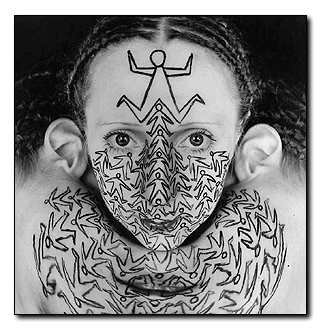![]()
![[ ARTS
]](/images/fall97/artsublogo.gif)
![]()
By Biray Alsac
biray@u.arizona.edu
Arizona Daily Wildcat September 23, 1997
Once upon a time...
![[Picture]](11_1_i.gif)
Nicholas Valenzuela Miriam Schapiro's "The Diary of a Young Artist" at the University of Arizona Museum of Art. |
Entertaining and eccentric anecdotes seem to give everyone's childhood a unique dimension. I'm sure we've all had someone significant who helped us become the person we are today, or perhaps shared an experience that has changed our outlook on a particular view.
In any case, everyone's childhood was full of memories that sculpted our individuality. Now, imagine remembering those moments of your early childhood and trying to share them with someone you don't know. It can be uncomfortable. How about sharing those memories through pictures?
How profound.
Memories of Childhood ... so we're not the Cleavers or the Brady Bunch is currently one of the featured shows at the UA Museum of Art. Fifteen fine American artists of different race, gender and ethnicity were asked to convey an early portion of their childhood through only 10 pieces of artwork. Each artist was also asked to provide a children's story to go along with each piece. It's not uncommon to find descriptions under each picture in a museum. But to read a children's story that was written by the artist that guides each picture is quite a clever concept. Rather than taking the attention away from the picture, each story complemented the visuals and brought out another dimension of the artist's past.

Photo courtesy of the University of Arizona Museum of Art. Rimma Gerlovina and Valerie Gerlovin's "Memories of Childhood #6: Fecundity." Both pieces can be seen in Memories of Childhood...so we're not the Cleavers or the Brady Bunch. The exhibition runs through Oct. 13 at the University of Arizona Museum of Art. |
Because of the nature of the exhibition's title, my immediate thought was that each artist had struggled with a difficulty that had prevented them from growing up in that "perfect" family environment, such as the Cleavers or the Brady Bunch. Then again, it might just have been that these artists didn't have television growing up and their identification with these shows were not as relevant to them as it is to our generation.
As I walked through the show, I noticed how certain works were more visually effective and could stand alone without the story, and others whose story added life to their artwork. Overall, the concept of telling the tale of one's childhood through a visual medium was definitely moving. Think about it: What would you chose to represent yours? How would you and why?
One artist, Roger Shimomura, started his story on his third birthday and then focused on single moments of his life. Another artist, Helene Brandt, focused on her relationship with her mother.
Although each artist's approach was different in style and presentation, my favorite was found in the photographs taken by Rimma Gerlovina and Valeriy Gerlovin. Their use of color and shapes on their own faces had such a visual impact. The integration of themselves into each picture plays with the balance of older representing the younger.
The University of Arizona Art Museum, located in the UA Arts complex, is Monday through Friday 9 a.m. to 5 p.m. and Sundays from noon to 4 p.m.



